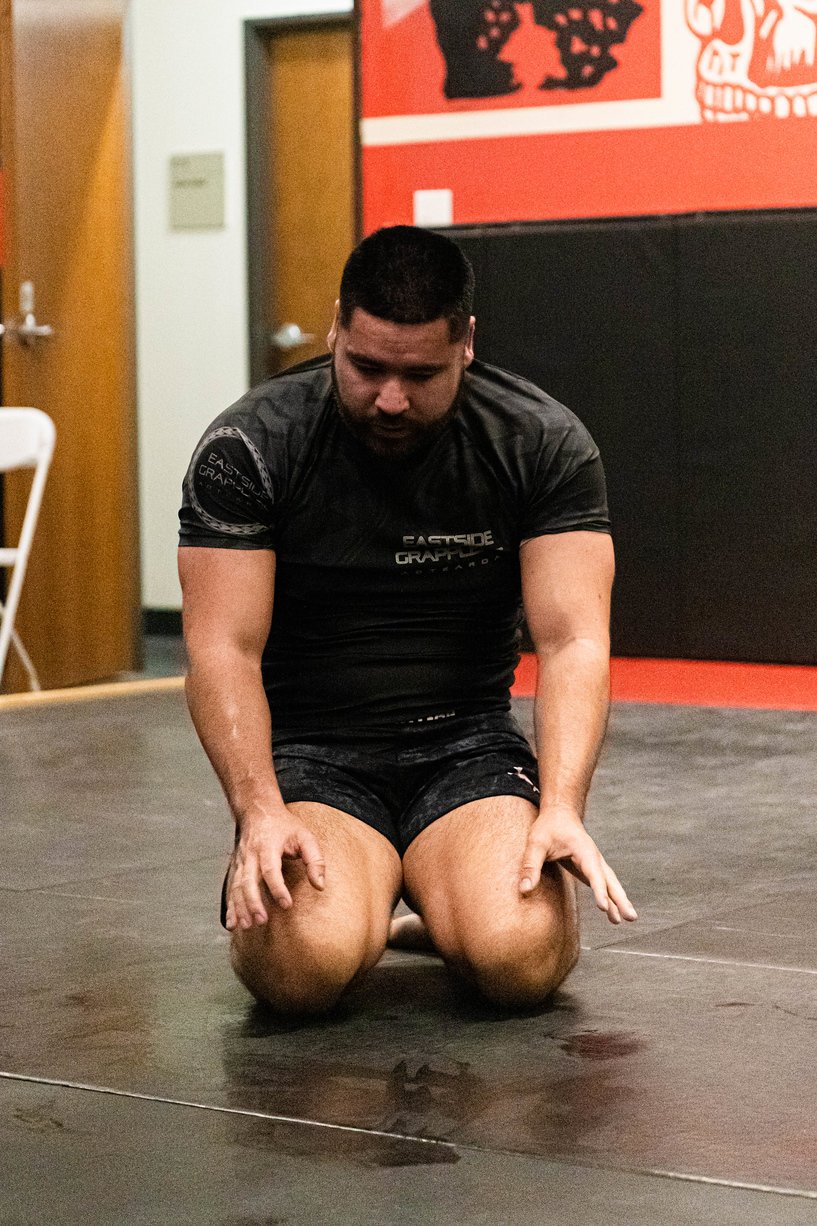BJJ and Karate are two separate forms of combat that, on paper, do not share much in common. Karate is one of the best arts when it comes to striking, while BJJ is the same for grappling. But if we set BJJ against Karate, which one is better and why?
BJJ entirely focuses on grappling and ground fighting. There is no striking, but it is very effective for self-defense and MMA. Karate has many styles and forms, out of which most focus on mixing kicks with the punches. The emphasis is on light contact and overwhelming the opponent with speed and precision.
Karate is also very practical for self-defense and MMA, but is it better than BJJ? Keep reading this article to discover all the answers in more detail.
What Is BJJ
BJJ is a grappling martial art that comes from Brazil. Its story begins in the 1920s when the famous judoka, Matsuo Maeda, traveled from Japan to Brazil to teach Judo. His loyal students, Carlos and Helio Gracie, would later use Judo as a base to create their own fighting system.
They moved the emphasis from throws to advanced ground fighting. Together, they developed various new positions, joint locks, escapes, and other moves.
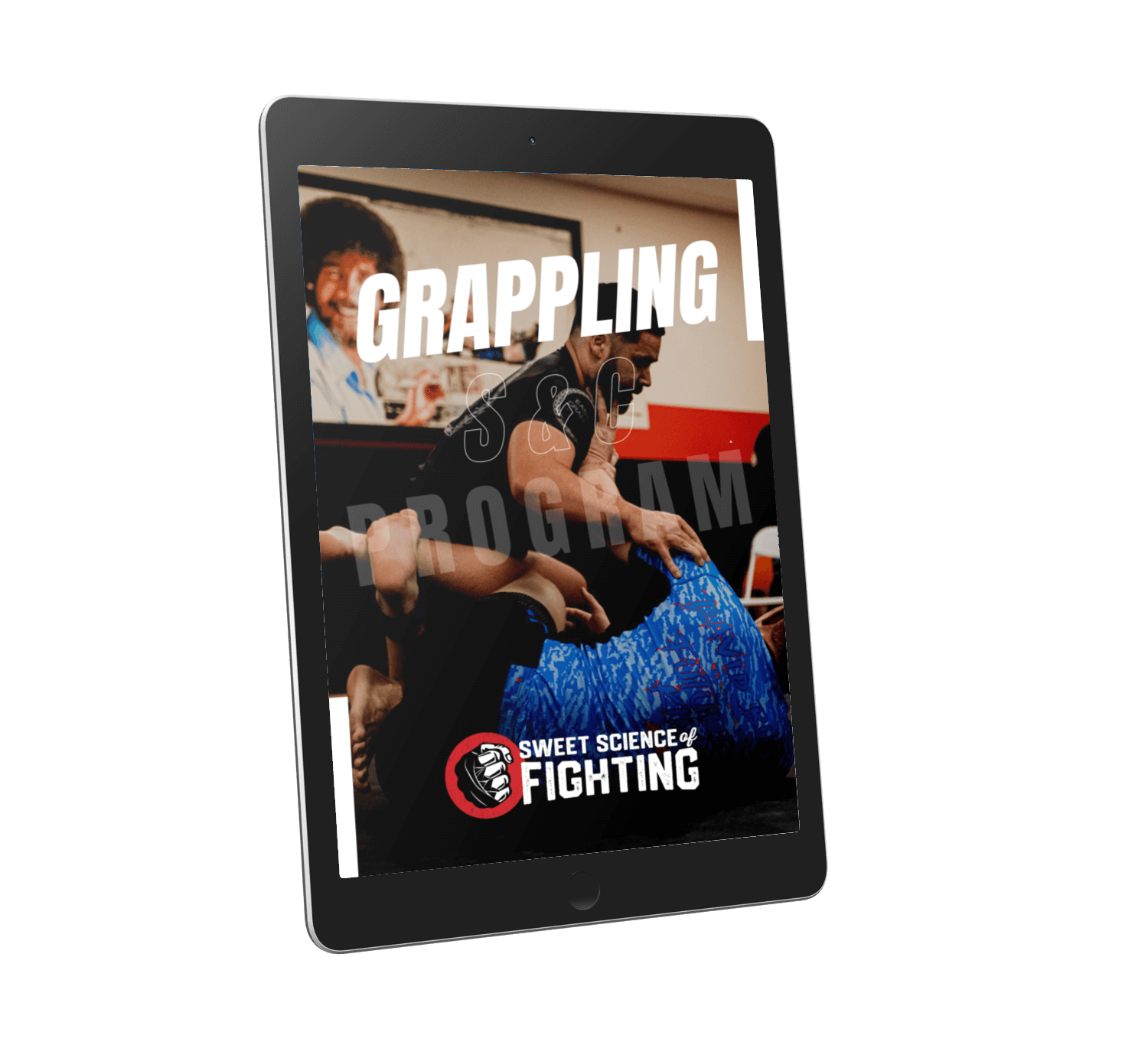
FREE Strength & Conditioning Program To Never Gas Out On The Mats
BJJ built its strong reputation on the streets of Brazil as an efficient system for self-defense. However, it would start to spread outside of Brazil in the early 90s with the birth of modern MMA in the US.
Early UFC events used to be a platform for style vs. style matchups where the main goal was to find out which martial art was the best. Thanks to Royce Gracie, who went on to win 3 UFC tournaments, BJJ emerged as the best.
During his campaign, Royce beat fighters who were often twice as big as he was, and he did in under the limited rules. But more about that later.
What Is Karate?
Karate is the most popular martial art that emerged in Japan at the start of the 20th century. There are many styles and forms of Karate, but the emphasis in most is mixing leg and hand strikes with knees and elbows.
Some styles also include the basics of grappling like trips and throws, and some original forms might also teach dirty tactics. The most popular styles of Karate are:
- Shotokan
- Kyokushin
- Goju Ryu
- Wado Ryu
- Shito-Ryu
Karate is a versatile striking system designed for self-defense and actual fighting. However, bear in mind that modern practice puts a lot of emphasis on competition. Students spend a lot of time learning to win matches under the “point fighting” rules.
These rules differ a lot from real fighting on the streets, which clearly impacts the image of Karate. On top of that, training includes a lot of katas where students practice techniques alone.
BJJ vs. Karate — What Is The Difference?
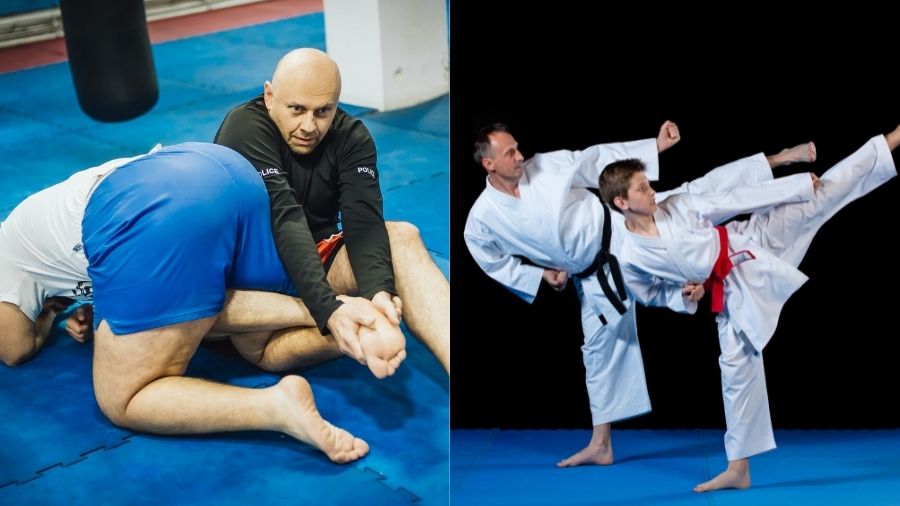
BJJ and Karate do not share much in common. In fact, these two differ a lot in just about every aspect of martial arts. Here is all you need to know:
History And Origins
As its name suggests, Brazilian jiu-jitsu comes from Brazil. It emerged in the 1920s when Japanese judoka, Mitsuyo Maeda, came to Brazil to teach Judo.
His loyal students were brothers Carlos and Helio Gracie, who, upon mastering Judo, have decided to create their own combat system. In short, they used Judo as a base to start BJJ that focuses much more on the ground fighting aspect.
Karate origins go back to the “Ryu Kingdom” and Chinese martial arts. In 1879, Japan annexed the Ryukyu Islands, which triggered the migration of people from Ryukyu to the main islands of Japan. Some of these people were trained martial artists who started teaching classes upon arriving on the island at the beginning of the 20th century.
Strategies And Emphasis
BJJ is a combat system that focuses entirely on grappling and ground fighting. Since every fight begins on the feet, the initial goal is to close the distance, secure a strong grip, and execute a judo throw, sweep, or trip the opponent.
Once the fight hits the ground, BJJ athletes fight for a dominant position to apply chokes and joint locks. There is no punching, kicking, or striking of any kind.
On the other hand, Karate is a striking martial art where the main goal is to learn how to strike using all limbs as weapons. Though traditional forms include the basics of grappling, the emphasis is on striking with punches, kicks, knees, and elbows. Most styles focus on light contact where the primary strategy is to beat the opponent utilizing a high level of technique.
Techniques
BJJ is a versatile martial art, and its techniques are very complex. This is the main reason why it is often seen as a human “chess match” on the ground. Here are some of the most popular techniques:
- Positions (back mount, full mount, side control, guard)
- Joint locks (armbar, kimura, leg lock)
- Chokes (rear-naked choke, D’arce, Anaconda, Triangle choke)
- Various sweeps, escapes, and throws
Karate techniques consist of dozens of different punches, kicks, elbow, knee strikes, throws, trips, and it’s impossible to list them all. Students spend a lot of time learning the moves alone practicing katas before moving to Kumite, which is sparring.
Also, bear in mind that the most practiced techniques are used in competition, which are punches and kicks.
Styles And Forms
BJJ has two main styles called “Gi” and “No-Gi”:
Gi– is a style where all athletes must wear a Gi uniform made out of thick cotton. They must wear it both during training sessions and competitions. In BJJ, a Gi uniform could also be used as a weapon to strangle the opponent or throw them down.
No-gi- is a style where athletes do not wear a Gi uniform. Instead, they wear a rash guard and BJJ shorts.
Karate has dozens of different styles and forms like: Shotokan, Shito-Ryu, Wado-Ryu, Goju-Ryu.
Belt Ranking System

BJJ belt ranking system has origins in Judo which the great Kano Jigoro developed. The number of belts and ranks varies between organizations. This list is based on the IBJJF belt ranking system with five different color belts and an additional three red belts. Bear in mind that each belt rank below the black belt has additional four degrees.
- White
- Blue
- Purple
- Brown
- Black Belt
- Red and Black
- Red and White
- Red
The karate belt ranking system varies between different styles and forms. But in most styles, the system includes eight different color belts:
- White
- Yellow
- Orange
- Green
- Blue
- Purple
- Red
- Brown
Strength & Conditioning
BJJ strength training is typically upper body dominant. Lower body strength doesn’t differentiate between different levels of BJJ practitioners. However, more wrestling-based rulesets such as ADCC would benefit from higher levels of leg strength. Karate strength training on the other hand highly benefits from lower body strength and power.
As punching power is derived mainly from the legs, lower body power-based exercises become more important. But maximal strength is far less important, especially for the upper body.
Karate kumite conditioning is highly aerobic and alactic. It has an activity to break ratio of 1:1 to 1:2 with high-intensity efforts lasting 1-5 seconds within a 6-11 activity period. BJJ conditioning is on another level of aerobic activity with a 6:1 activity to break ratio giving BJJ greater aerobic requirements.
BJJ vs. Karate For Self-Defense
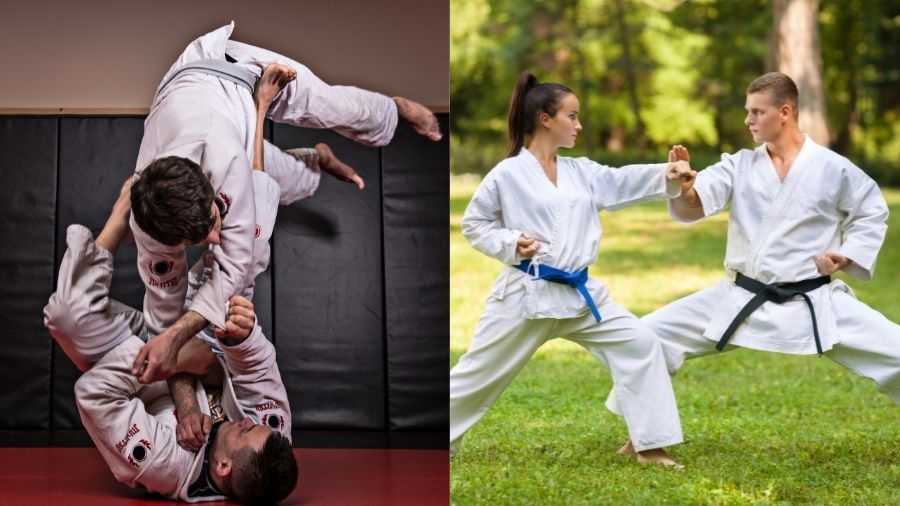
BJJ is better than Karate in self-defense since its techniques are more practical and effective. Karate is also good, but the modern practice is too oriented towards point fighting and light contact. In some way, the emphasis has moved from the self-defense aspect to competition, impacting the effectiveness of Karate as a combat system.
BJJ is a battle-proven martial art that has built its strong reputation on the streets of Brazil and inside the MMA cage. Do not look any further from the early UFC events to see how and why it is so effective. These early UFC events were legal street-fighting events with no rules like rounds, forbidden strikes, or even weight classes.
At the time, MMA matches were style vs. style matchups where BJJ emerged as the best. Royce Gracie beat fighters from all other styles like wrestling or boxing, and he did it easily. In an environment that was as close to street fighting, BJJ techniques proved as the most effective ones. But why?
First of all, most street fights are chaotic, all over the place, and include a lot of grabbing. This is where fighters trained in BJJ shine because they need to grab just a single part of your body to take the attacker down.
Combine this with the fact that most ordinary people don’t know how to grapple, and you get why BJJ is the best. Even if the attacker is a trained striker, it won’t help them much. They would all look lost and desperate while trying to survive on the bottom. And we don’t have to bring submissions into the conversation.
BJJ is also very effective for women because it is, perhaps, the only martial art that allows a small person to beat bigger attackers. In most scenarios, women get attacked by physically more powerful men. They can use this advantage to take them down to the ground.
But BJJ trains you to attack from the bottom with various submission moves, and no matter how big the attacker is, catching them in a submission won’t be hard if they are not trained to defend against these moves.
On the other hand, Karate is also practical but not as much as BJJ. The thing is, the concept of Karate is all about light contact and beating the attacker with speed, a high level of technique, and precision. The main goal is to defend without causing injuries, which sounds nice on paper. But the reality of fighting is a bit different.
BJJ vs. Karate For MMA
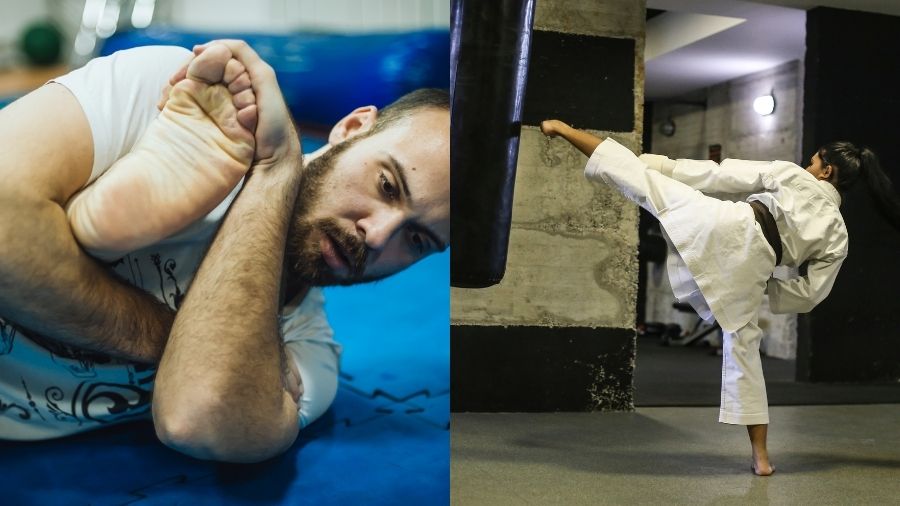
BJJ plays a vital role in modern MMA fighting, and it has been like that since day one. In fact, it’s fair to say that top-level fighters can’t expect to succeed in the game without BJJ skills. Sooner or later, the lack of grappling and ground fighting game would catch up on you. On the other side, Karate is also present in cage fighting, but not as much as BJJ.
According to studies, MMA is dominated by wrestlers and BJJ fighters. They are the ones who choose where the fight takes place and are far more superior when the fight hits the ground.
As you know, MMA fighters need to know how to strike and grapple. But grapplers would always have an advantage here because a striker needs much more time to learn how to grapple than a grappler to learn how to strike.
BJJ fighters can learn to block punches and check kicks after just one trip to Thailand. On the other hand, a trained striker would need to spend years working hard to learn how to defend a takedown or escape from the bottom.
And on top of that, they also must learn how to defend against chokes and joint locks. This is the main reason why MMA is a sport dominated by grapplers.
Is Karate Good For MMA?
As a versatile striking art, Karate fits well within the rules and demands of cage fighting as far as striking is concerned. Its fighters are masters in keeping their range, are always on the move, and are very hard to hit. Some of the most famous are Stephen Thompson, Lyoto Machida, and George St. Pierre.
BJJ vs. Karate – Which One Is Harder And Takes More Time To Learn?
BJJ takes more time to master, and it is also harder than Karate. On average, BJJ students need from 7 to 10 years to earn a black belt rank. You can do it in less time if you possess a rare talent, but bear in mind that there are also people who need more than ten years.
BJJ is too complex and versatile that learning never stops in some way. There are always new techniques and moves to master.
On top of that, training is challenging and not beginner-friendly like in Karate. Beginners have to spend the first couple of months surviving on the mats and close to a year before they can make some significant progress.
How Long Does It Take To Reach Black Belt In Karate?
Karate training is not that hard, but on the other side, the progress is slow due to strict promotional criteria. On average, students need around 3–5 years of training before reaching the black belt rank.
The intensity of training varies between different styles, with Kyokushin, for instance, being even harder than BJJ. But most others emphasize light contact and are not that hard on your body.
Bear in mind that becoming a master in any martial art or sports, in general, takes a lot of time. It is a lifelong journey for most people, and the same stands for BJJ and Karate.
BJJ vs. Karate — Who Would Win In A Street Fight?
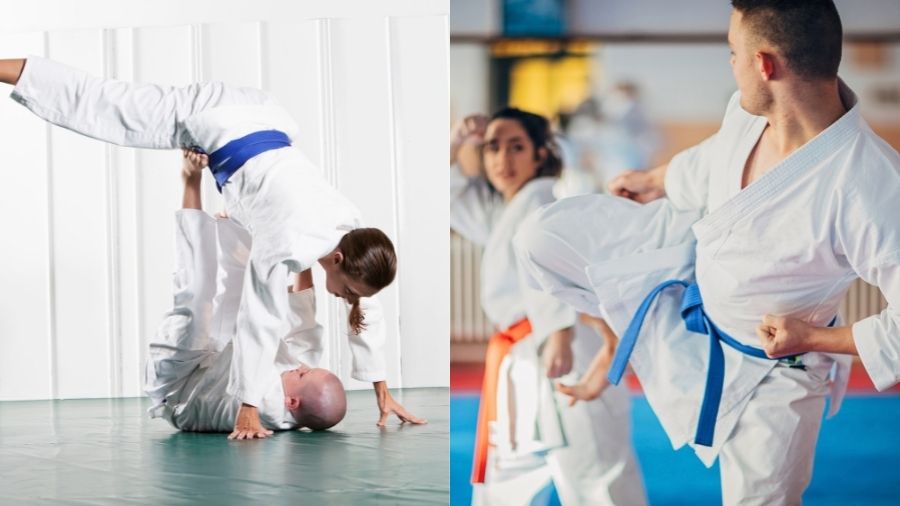
Athletes trained in BJJ have better chances of beating karateka in a street fight. It is hard to imagine the fight going the other way around as BJJ is superior to Karate in most aspects. Both Karate and BJJ focus too much on competition and fighting under the rules. But the concept of BJJ and its techniques are more practical for street fighting.
BJJ vs. Karate is a typical grappling vs. striking matchup. Knowing how to take the opponent down and fight on the ground is a significant advantage. That said, BJJ has a big advantage if the fight is in a closed space like a bar, club, or room.
To use their weapons, grapplers need to close the distance and get a hold of the opponent. Once a BJJ athlete secures a strong grip, just about every karateka would go for a ride down. And once the fight goes to the ground, it would be a game over. But, this doesn’t mean that karatekas do not stand any chances.
Can A Karateka Beat A BJJ Fighter In A Street Fight?
The chances of karateka beating a BJJ athlete increase if the fight is in an open space. This is because karatekas are masters in utilizing footwork to keep their range, and it’s tough to cut their movement. If they have enough space to operate, they could easily pick a BJJ athlete apart from a distance utilizing fast and precise punches and kicks.
BJJ vs. Karate — Which One Is Better For You?
BJJ and Karate are two martial arts that differ in almost every aspect, with BJJ being superior in most. Does this mean you should choose it over Karate? The answer to this question truly depends on what you want to achieve or which style you prefer. Here is a final look at both of these arts that might help you make the right pick.
BJJ is a modern martial art that has skyrocketed over the last two decades. It should be your choice if you are a fan of grappling, or in the case you don’t know if you are, give it a try.
Training is fun, dynamic, playful, and above all, safe because it doesn’t include any striking. BJJ embraces a strong culture and positive atmosphere and is very popular among people in their 20s or 30s and kids. You will start sparring from day one and learn all about actual fighting.
On the other hand, Karate is a striking martial art that is very popular among kids. Although there are exceptions, you will rarely see adults joining karate dojos. Instead, most go to other striking arts like boxing or Muay Thai. As an adult, you might have a hard time fitting in.


